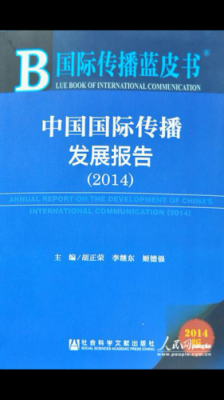Read this article in Spanish here.
It may have the world’s second largest economy, but China does not have the second loudest voice in a noisy news media world.
My country is trying to fix that disparity, and according to the first “Blue Book of International Communication,” released at a major conference here in June joining scholars with professionals, China’s media are making progress.
For insight into how China fits into the world picture, please turn to a companion piece, “Part II: An American’s View,” written by University of Kentucky professor Buck Ryan, who cites a content analysis and reflects on early America, Franco’s Spain, and Putin’s Russia.
For now you can learn about the “Annual Report on the Development of China’s International Communication (2014),” see what prominent Chinese and American thinkers have to say, and hear my views on China’s missing links, including a “Cronkite” and a “Ginsburg.”
Here’s how the blue book opens with one side note:
“Organized by the National Center for Radio and Television Studies of Communication University of China,” that’s the top university for media studies in the country, “this blue book is the first professional report on the development of China’s international communication and also an unprecedented joint effort of both government departments, mainstream media, education, culture and information organizations who have done distinguished studies on this topic domestically and beyond.”
I did not want to miss this historic conference. I so looked forwarded to meeting foreign correspondents and scholars from America. Only one thing: the event was focused on China for China.
Some researchers at the conference think one problem is China’s news media do not put their focus on the foreign audience. They do not focus on what the foreign audience needs, so we cannot achieve a good effect for international communication.
Kerry Luft, former Nation & World editor for the Chicago Tribune who now works for Bloomberg in New York City, added another concern in an email exchange about China’s English-language news media, including CCTV in America.
Luft suggested that if the Chinese news media provided more precise details in their reporting than they could achieve more credibility in his eyes.
Terry Anderson, the legendary Associated Press foreign correspondent who now is at the University of Florida to teach international journalism, said in an email exchange that he sees the difference between China and America in the classroom. In his teaching, Anderson said, he explains how America’s journalism culture clashes with the Chinese way of seeing professional practice.
The challenge for China is to achieve “20/20 vision” so its news and information is seen clearly by both Chinese and American audiences. Asked for his view, a Chinese scholar focused on the differences between popular ideas and content that has ideological value.
“Popularization is a kind of form and measure to realize ideological value,” said Jilin University professor Zhang Fugui, Changjiang Scholar of China. “As a form and measure, investigators should try their best to popularize the understanding of ideological content of the research object in order to popularize the very idea.”
According to blue book statistics, China achieved significant accomplishments over the last 10 years to strengthen its news media institutions abroad. Here are some examples:
1. By 2013, Xinhua News Agency expanded to 141 countries, gaining on Agency France-Presse, with offices in 150 countries, and surpassing Reuters and the Associated Press with offices in more than 100 countries.
2. CNC World, a 24-hour global English-language news channel launched in 2010, has reached 800 minutes a day with both Chinese and English TV news programming, rivaling CNN and the BBC coverage.
3. CRI, or China Radio International, has built eight regional stations (Africa, Asia, North America, Western Europe, Eastern Europe, Latin America, the Middle East, Oceania), 32 reporter stations and 23 overseas studios in more than 70 countries. The reach in radio frequency is now believed to be second only to the BBC.
4. CCTV, or China Central Television, the predominant state television broadcaster in mainland China based in Beijing, now has 63 overseas reporter stations.
5. CIPG, or China International Publishing Group, now publishes more than 4,000 foreign publications in nearly 20 languages annually. More than 30 journals such as “Beijing Review,” “China Today,” “People’s Pictorial,” “People’s China,” and “China Report” in Chinese, English, Spanish, French, Arabic, Russian, and Korean are published in more than 180 countries and political districts all over the world.
Beyond the reach of news media, according to the blue book, China is expanding knowledge of Chinese language and culture through Confucius Institutes. By the end of 2013, 440 Confucius Institutes have been set up in 120 countries and political districts around the world.
So with all that progress, you would think China’s voice would rival America’s, right? No, her voice is not the second loudest in the news media world, and I think that is because of a creativity gap.
For one thing, China lacks a “Cronkite” in its news media who can command national attention within the country as a trusted news source. U.S. journalists praise the glory days when CBS News anchor Walter Cronkite was the “most trusted man in America.”
In his memoir, “A Reporter’s Life,” Cronkite tells about “breaking into” journalism by stealing a photo from a victim’s home only to be criticized by his boss. The problem was not stealing, he said. He said he learned a lesson about double-checking his facts: he had the wrong address.
Cronkite traveled a long road to his success, just as we at Jilin University in Changchun, China, have begun our journey. We have opened a brand new College of Journalism and Communication, so we have a great opportunity to help China raise its voice to a higher level.
One challenge is ethics. This spring government authorities began cracking down on journalists accused of false news reports, bribes, and extortion.
In July a prominent business journalist on state-owned CCTV was taken into custody just before he started work. Rui Chenggang, who gained famed with commentaries that chased a Starbucks store away from the Forbidden City, was arrested along with the network’s vice-director of financial news, Li Yong, according to the Communist Party’s newspaper, the People’s Daily.
Our journalism students have much to learn. If our journalism school can create China’s “Cronkite,” then a law school might create a “Ginsburg,” who can make the rounds on Sunday morning news programs in America to argue her case when big international news breaks.
Even better than an attorney, China needs a prominent journalist who can get her points across on the front pages of the New York Times, Chicago Tribune or Wall Street Journal, or on the network or cable news programs.
One hopeful sign at the blue book conference came from BON TV, the first privately owned Chinese commercial TV network, whose Blue Ocean Network documentaries are helping foreigners to know the real China.
China is the country I love and I want to help her to make progress in the news media world. Maybe someday, with the help of my journalism school, she will indeed have the second strongest voice to match her economic success.


